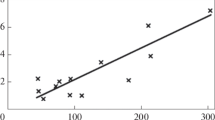Conclusions
-
1.
The optimal profile and massiveness of the heater section can be selected using Eqs. (7)–(12).
-
2.
In the majority of cases, a circle (wire) should be considered the optimal profile of the HE section. A rectangle (strip) may offer an advantage over a circle in cases where the HE is used at temperatures close to the maximum allowable, and with significant "HE/heated-component" temperature gradients, and when negligible metal is consumed by the heating elements.
-
3.
As compared with iron-chromium-aluminum He, chromium-nickel resistance alloys are preferred for the fabrication of HE for electric forced-heating furnaces, for charges of high heat capacity, for electric furnaces with an oxidizing atmosphere, at high (150°C and above) temperature gradients between the heat-emitting and heat-receiving surfaces, for high (above 2.0 W/cm2) specific HE surface capacities, and for furnaces with charges having a large heat-receiving-surface area and a high degree of blackness.
-
4.
In developing new resistance alloys, we should strive to provide them with a high degree of blackness, which increases with increasing temperature.
-
5.
In developing refractories and heat-resistant steels for the fabrication of intrafurnace components and designs that are not heat-emitting, conversely, it is necessary to reduce their degree of blackness, since this will make it possible to reduce their temperature and increase their service lives.
Similar content being viewed by others
Literature cited
Electrothermal Equipment (Handbook) [in Russian], 2nd ed., A. P. Al'tgauzen (ed.), Énergiya, Moscow (1980).
V. P. Isachenko, V. A. Osipova, and A. S. Sukomel, Heat Transfer [in Russian], Énergiya, Moscow (1975).
A. D. Svenchanskii, Electric Furnaces [in Russian], Part 1, Énergiya, Moscow (1975).
I. V. Voronkin, M. B. Gutman, N. F. Shur, and A. B. Plotkin, "Interrelation between the wire diameter and service life of heaters formed from resistance alloys," Élektrotekh. Prom., Ser. "Élektrotermiya", No. 8 (246), 1–2 (1983).
A. B. Plotkin, M. B. Gutman, and Yu. V. Shumkov, "Effect of temperature and wire diameter on the service life of iron-chromium-nickel alloys," Élektrotekh. Prom., Ser. "Élektrotermiya", No. 2 (198), 10–12 (1979).
I. V. Voronkin, N. F. Shur, and M. B. Gutman, "Investigation of the structure and properties of heat-resistant steels and high-temperature-corrosion-resistant materials in carbon-containing atmospheres," in: Nickel-Base Heat-Resistant and High-Temperature-Corrosion-Resistant Steels and Alloys [in Russian], Nauka, Moscow (1984), pp. 119–124.
Additional information
All-Union Scientific-Research Institute of Electrothermal Equipment. Translated from Metallovedenie i Termicheskaya Obrabotka Metallov, No. 2, pp. 54–58, February, 1986.
Rights and permissions
About this article
Cite this article
Voronkin, I.V., Gutman, M.B. & Shur, N.F. Selecting the design and material for the heating elements of electric resistance furnaces. Met Sci Heat Treat 28, 149–154 (1986). https://doi.org/10.1007/BF00717540
Issue Date:
DOI: https://doi.org/10.1007/BF00717540




